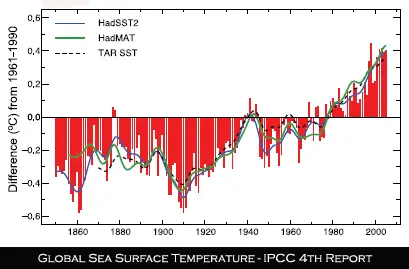Sea temperature is rising and the oceans are warming. Over the period 1961 to 2003, global ocean temperature has risen by 0.10°C from the surface to a depth of 700 m. Ocean biogeochemistry is also changing. The total inorganic carbon content of the oceans has increased by 118 ± 19 GtC between the end of the pre-industrial period (about 1750) and 1994 and continues to increase.
The ocean has an important role in climate variability and change. The ocean’s heat capacity is about 1,000 times larger than that of the atmosphere, and the oceans net heat uptake since 1960 is around 20 times greater than that of the atmosphere. This large amount of heat, which has been mainly stored in the upper layers of the ocean, plays a crucial role in climate change, in particular variations on seasonal to decadal time scales. The transfer of heat into the ocean also leads to sea level rise through thermal expansion.

NASA funded scientists have shown that a warming in sea temperature over the past decade has caused a global decline in phytoplankton productivity.
Is this important? It sure is, more than 100 million tons of carbon dioxide is taken from the atmosphere and absorbed into the ocean each day. This work is done by countless millions upon millions of tiny ocean plant life called phytoplankton, through the process of photosynthesis. Whilst they play a vital role in absorbing greenhouses gases from our atmosphere, the phytoplankton also form the foundation of the mighty ocean food chain.
Scientists suggest, the most likely explanation for warm temperature killing of phytoplankton is that the warmer the surface waters become, the less mixing there is between those waters and deeper, more nutrient-rich water. As nutrients become scarce at the surface, where phytoplankton grow, productivity declines. The effect is most obvious in the part of the world’s oceans that scientists describe as the permanently stratified ocean, bounded by black lines in the images. “Permanently stratified” means that rather than being well-mixed, there is already a distinct difference in the density of warmer, fresher water at the surface and colder, saltier water deeper down.
In this situation, with “lighter” (i.e., less dense) water on top, and “heavier” (denser) water below, there is little vertical mixing, and nutrients can’t move to the surface. As surface water warms, the stratification, or layering, becomes even more pronounced, suppressing mixing even further. As a result, nutrient transfer from deeper water to surface waters declines, and so does phytoplankton productivity.
“Rising levels of carbon dioxide in the atmosphere play a big part in global warming,” said lead author Michael Behrenfeld of Oregon State University, Corvallis. “This study shows that as the climate warms, phytoplankton growth rates go down and along with them the amount of carbon dioxide these ocean plants consume. That allows carbon dioxide to accumulate more rapidly in the atmosphere, which would produce more warming.”Ocean acidification, which is a direct result of the increase in atmospheric carbon dioxide levels will also affect marine life with a disastrous result.
Equally important is the sea level change associated with sea temperature and the resultant thermal expansion, which leads to sea levels rising. Sea levels have already begun to rise around the world and this has extraordinary implications and will displace many people.
Sea surface temperatures above 26.5 degrees C are also generally favorable for the formation and sustaining of tropical cyclones. Generally the higher the temperature, the stronger the storm.
Fish distributions and biodiversity of regions are both strongly influenced by temperature. This is also a cause of an important stress for corals. During 1998 and 2002 significant proportions of the Great Barrier Reef were bleached due to higher sea temperatures.
